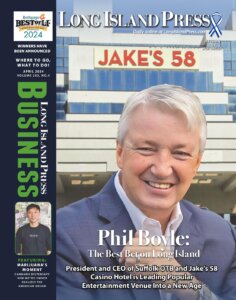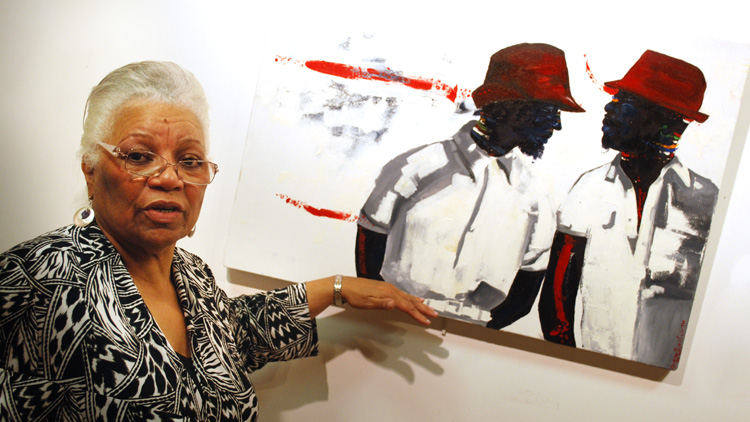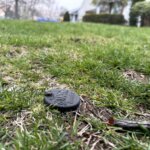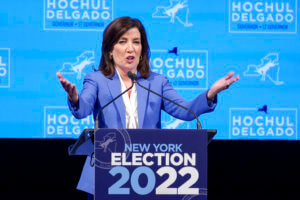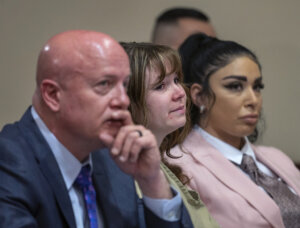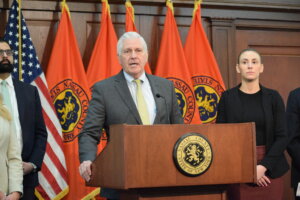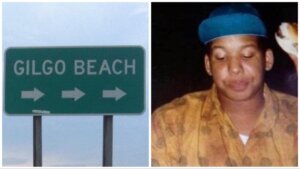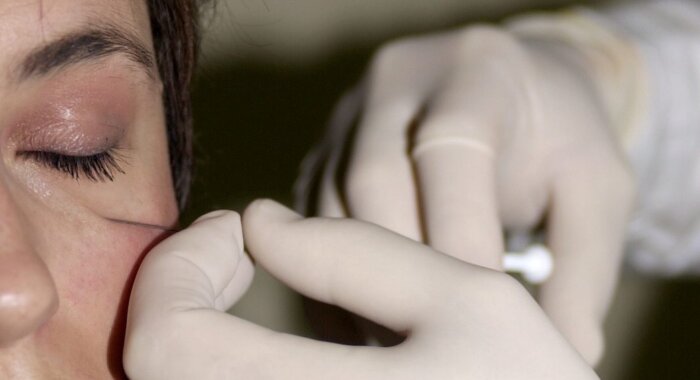On a dull gray day when winter chills the air, the horizontal beige building on the busy corner of North Franklin and Jackson streets in Hempstead almost fades into the background given the commercial surroundings. The outdoor sign heralding what’s inside is neither at eye level nor apparently near enough the entrance to stop the random passersby.
But those in the know are well aware that this place is a rare community jewel. The African American Museum of Nassau is the only one of its kind in our three-state area. The fact that this 6,000 square-foot space survives despite the county’s fiscal fiasco and official indifference, to put it charitably, is almost miraculous.
But it does. Inside its walls are the spirited paintings and sculptures by internationally known artists as well as Yoruba tribal masks, other African artifacts, American slavery shackles, fascinating historical exhibits and even the grand piano belonging to ragtime composer Eubie Blake, who was immortalized by the Broadway musical “Eubie!” Under its roof are stages for performances, areas for community meetings and catered weddings, a room for researching genealogy and a small recording studio for a scratch DJ. And keeping it going since 2012 when County Executive Ed Mangano laid off the museum’s full-time staff in his bid to balance Nassau’s budget under pressure from the Nassau County Interim Finance Authority is a remarkable confluence of people: a combination of semi-retired professionals, dedicated volunteers and steadfast county seasonal workers.
The credit would have to go to its unlikely 75-year-old executive director, Joysetta Pearse, a certified genealogist whose boundless energy and insatiable curiosity is coupled with the support of her husband Julius, a retired Freeport policeman, now 80, who is the president of the Dr. Martin Luther King, Jr. Birthday Celebration Committee, Inc., as well as The African-Atlantic Genealogical Society, Inc. (She’s also its executive director.) If it weren’t for the Pearses’ genealogical pursuits, it’s hard to say who would have kept the museum’s doors open after the county slashed its support, because their group was the only one left in the building with the required 501(c)3 nonprofit tax status to accept deductible donations and contributions. The county has owned the building since 1985. The site’s previous claim to fame is that the Isley Brothers once recorded there, and their sound engineer’s control room is now where Fatimah White, the museum’s multi-talented art education director, runs art classes.
The museum’s genesis took root in 1968 when Leroy Ramsey, a professor at Nassau Community College, took pieces from his collection and exhibited them in a hallway at the college for Black History Month. Students didn’t want him to take it down when the month was over so the pieces remained on display for two more years. But the college eventually wanted the space back, so he took the work to a storefront on Main Street in Hempstead. Then, in 1985, Russell N. Service, the first African-American deputy Nassau County executive, convinced Ramsey to come to the present space with his artifacts.
“He had fabulous slave shackles, even for babies,” says Joysetta Pearce, who spoke to Ramsey a few months before he died in the spring of 2013. Over the years he’d lost contact with the museum but when she reached out to him, he was eager to pitch in once more. “Leroy brought all of his stuff over here,” she says with admiration. In his honor the museum hosts the Leroy L. Ramsey lecture series twice a year so his legacy lives on.
Cataloguing all that the museum has accumulated since Ramsey first began exhibiting his collection has been a challenge.
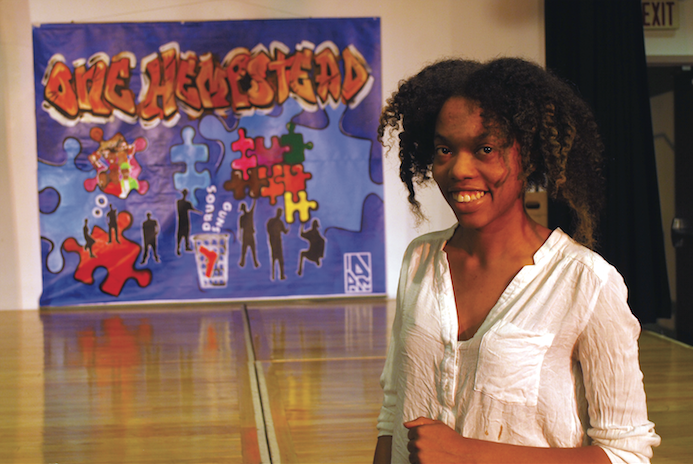
Some of the objects on display these days were found in the basement, which “looked like an auto repair shop,” Pearse says. Many donations did not have a verifiable provenance. For example, on one wall of a room inside the museum stands a series of intricately carved wood panels stretching from the floor to the ceiling that depict the effect of the slave trade on an archetypal African village. It’s a stunning piece of work showing scenes of happiness, captivity and salvation. But the trouble is that the artifacts were donated by a Nassau County widow who did not know where her husband had acquired it decades before in Africa. The couple had never displayed the panels at home because they were too tall.
Pearse, who has no formal art training, had become a certified genealogist after retiring from NYNEX. Asked if she ever thought she’d hold the position she does now, she laughs and says, “Never!” But it’s not that much of a stretch, considering her lifelong love of history and that when she was younger, she was “very much interested in art.” In fact, she says, “I was a museum nut!” Before she and her husband moved to Freeport, they lived in Brooklyn and their two kids were at the Brooklyn Museum “every Saturday.”
She can only wish that the Hempstead facility had the same kind of financial and governmental support. But it has garnered some much-deserved recognition over the years. In 2005 it was honored by American Legacy magazine with its Museum Preservation Award as one of only 10 museums the publication recognized for their work done to preserve African-American history and culture. That was a tribute to the leadership of then-director and curator David Byer-Tyre, who oversaw extensive remodeling of its galleries and installed mosaic murals in the lobby. He also facilitated the acquisition of photographs and historical accounts of the oldest African Methodist Episcopal Churches on Long Island, a collection of African-American imagery from 1806 to 1930, and the collected work of Pulitzer Prize winner and noted civil rights photographer Moneta Sleet, Jr.
These days, the curator and art director is Minna Dunn, 66, an unpaid volunteer who has brought in internationally known artists like Frank Frazier and Ernani Silva, to name just two. Silva’s expressionistic canvasses, which spring to life with primary colors and organic objects like pasta, vines, coffee grounds and even bark, occupy the main gallery space.
Born in extreme poverty in Rio de Janeiro with a mother from the Amazon, a grandmother from Nigeria and a grandfather from Germany, Silva came to America in 1969 to flee Brazilian repression—he’d been beaten by the police and his friends had been killed after protesting the regime—when an American professor at Columbia University helped him emigrate. He has studios in Brooklyn, Florida and Massapequa, where his house is brimming with paintings. His work, which sells from $10,000 to $40,000, has been collected by the likes of President Jimmy Carter, Sen. Ted Kennedy and Princess Anne. His imagery can range from the joyous, like a carnival on canvas, to the mystical, like masks used in an ancient ritual, or to the painful, like the outrage over political injustice. His art is on temporary loan at the gallery in Hempstead.
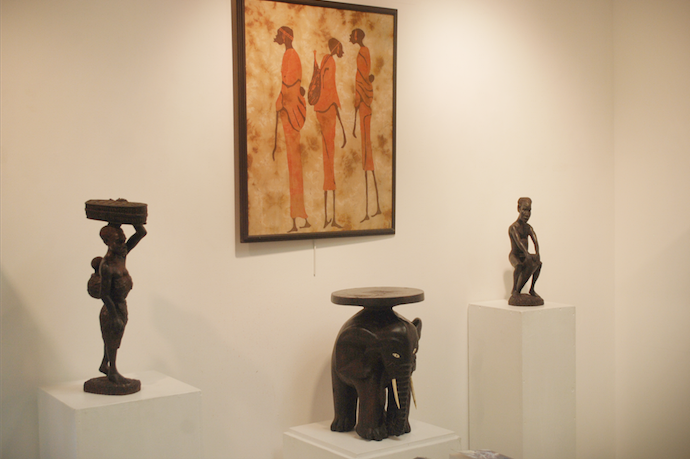
“Art can change people’s lives!” Silva tells the Press at his Long Island studio. His own life is a testament to that.
“I like art that tells a story, not just art that is pretty,” says Dunn, who has put together shows at the Black Congressional Caucus in Washington, the Jacob Javits Center in Manhattan, as well as traveling exhibitions that have appeared in Canada as well as throughout the United States. Dunn, who lives in Massapequa, has been connected to the African American Museum in Nassau since the early 1990s when she helped bring in the brilliant geometric work of South African artist Esther Mahlangu. Since she became the official curator in Hempstead she’s done seven shows.
“You can’t have people without history,” says Dunn. “One way of showing that history is through visualization and art. People are expressing that with a paintbrush and a canvas; they are expressing it through voice, through singing, through stage, through drama.”
The next history exhibit, timed for Black History Month, will focus on Pyrrhus Concer, also spelled Consur, a black whaler from Southampton in the 19th century who accompanied his captain Mercado Cooper around the globe, and together they sailed into Tokyo seven years before Commodore Perry did. Born a slave in 1814, Pyrrhus had been owned by Nathan Cooper, Mercado’s father, but he proved his prowess as a skilled pilot of a whale boat. The museum is also planning an exhibit on the massacre of a prosperous black community in Tulsa, Oklahoma, known as “Black Wall Street,” that was burned to the ground by the KKK in 1921.
“It’s hidden history,” says Pearse. “It’s controversial.”
Pearse used to just take on a person’s individual past but now through the work of the museum she and her dedicated staff help connect a people to their common experience.
“There’s a lot of history that we need to know in order to understand who we are and what we should be about,” she says. “You can’t study history if you don’t study art. And you shouldn’t study art if you haven’t studied history! They both enhance each other.”
The trick is how to let more of the public know the museum is there.
The African American Museum of Nassau, 110 North Franklin St., Hempstead, is open Tuesday through Saturday, 10 a.m.-5 p.m., with an open art studio workshop on the weekend for ages 1 to 16. Call 516-572-0730 or email [email protected]. Admission is $3 per adult.
